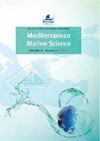In situ observation of circadian rhythm of polyps’ opening and closing of the coral Dendrophyllia ramea (Linnaeus, 1758)
IF 2.3
3区 环境科学与生态学
Q1 MARINE & FRESHWATER BIOLOGY
引用次数: 0
Abstract
A widespread population of the coral Dendrophyllia ramea has been revealed southeast of Syracuse (East Sicily, Italy) at around 75 m depth. Dendrophyllia ramea is an arborescent scleractinian coral, classified as “Vulnerable” in the Mediterranean IUCN Red List and listed in Annex B of the Barcelona Convention. It is considered rare because it is seldom recorded on the Mediterranean seabed. In situ observations of two selected colonies were carried out over three months using a custom-made underwater video recording system to increase knowledge about the ecology of the species, specifically its circadian rhythm. The area was also surveyed using a special navigation system integrated into a diver propulsion vehicle to map the colonies’ position and distribution. The rhythms of the opening and closing of Dendrophyllia ramea’s polyps during the day were studied and linked to environmental factors, such as temperature, water flow, and direction. The results show that Dendrophyllia ramea opens and closes its polyps according to its circadian rhythm and water flow in analogy with other anthozoans in different environments. The opening/closing frequency analysis showed that both colonies closed at least once daily with different periodicity; one colony closed on average a few hours earlier. This project gathered important information on D. ramea’s circadian rhythm, which is relevant for improving knowledge about the ecology of this species since it provides insights into its feeding behavior, reproduction seasonality, response to environmental changes, interactions with other species, and conservation needs.珊瑚树突(Dendrophyllia ramea)珊瑚虫开合昼夜节律的原位观察(Linnaeus, 1758)
在锡拉丘兹东南部(意大利西西里岛东部)约75米深的地方发现了一个广泛分布的珊瑚种群。树突珊瑚是一种树状硬核珊瑚,在世界自然保护联盟地中海红色名录中被列为“易危”珊瑚,并列入《巴塞罗那公约》附件B。它被认为是罕见的,因为它很少在地中海海底记录。在三个多月的时间里,我们使用了一套定制的水下录像系统,对两个选定的种群进行了实地观察,以增加对该物种生态的了解,特别是其昼夜节律。该地区还使用集成在潜水员推进器中的特殊导航系统进行调查,以绘制殖民地的位置和分布。研究人员研究了白桦息肉在白天打开和关闭的节律,并将其与温度、水流和方向等环境因素联系起来。结果表明,与其他珊瑚虫在不同的环境中一样,树突根据自身的昼夜节律和水流来打开和关闭珊瑚虫。开启/关闭频率分析表明,两个菌落每天至少关闭一次,但周期不同;一个蜂群平均提前几个小时关闭。该项目收集了关于滇凤蝶昼夜节律的重要信息,为了解滇凤蝶的摄食行为、繁殖季节性、对环境变化的反应、与其他物种的相互作用以及保护需求提供了重要的信息。
本文章由计算机程序翻译,如有差异,请以英文原文为准。
求助全文
约1分钟内获得全文
求助全文
来源期刊

Mediterranean Marine Science
MARINE & FRESHWATER BIOLOGY-
CiteScore
5.20
自引率
17.90%
发文量
34
审稿时长
>12 weeks
期刊介绍:
The journal Mediterranean Marine Science (MMS), published by the Hellenic Centre for Marine Research (HCMR), issues three volumes annually. The journal welcomes original research articles, short communications, New Mediterranean Biodiversity records, extended reviews, comments, and Theme sections in all fields of Oceanography, Marine Biology, Marine Conservation, Fisheries and Aquaculture in the Mediterranean area and the adjacent regions. All content is peer reviewed.
 求助内容:
求助内容: 应助结果提醒方式:
应助结果提醒方式:


